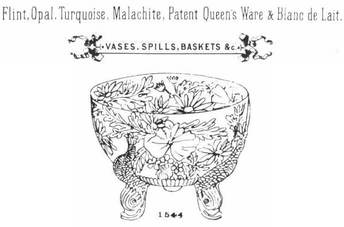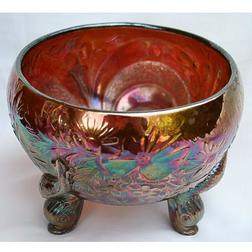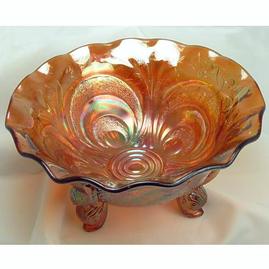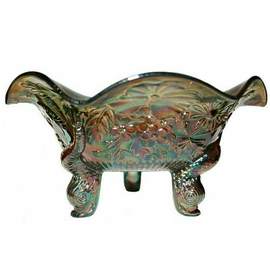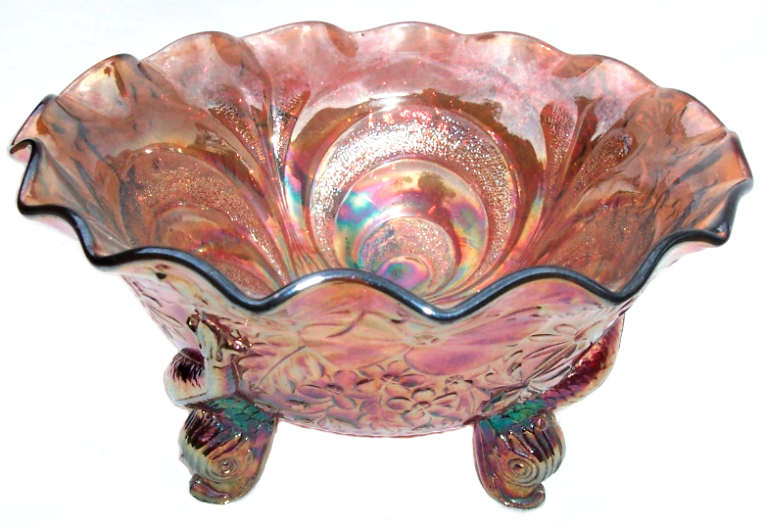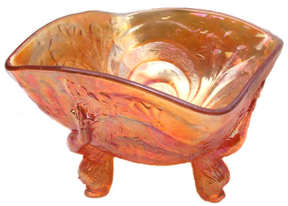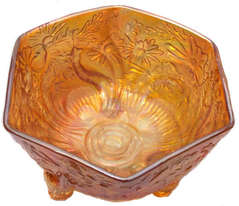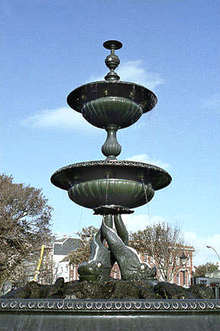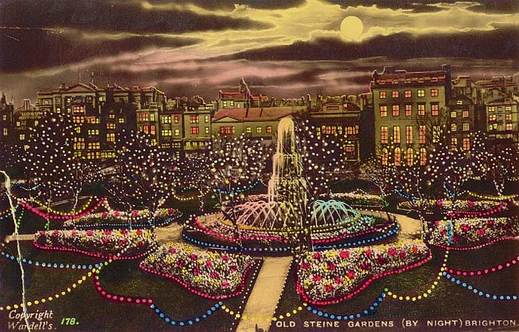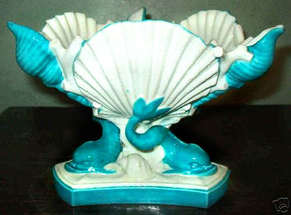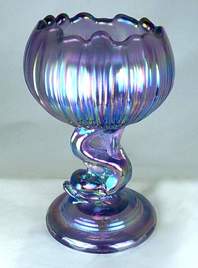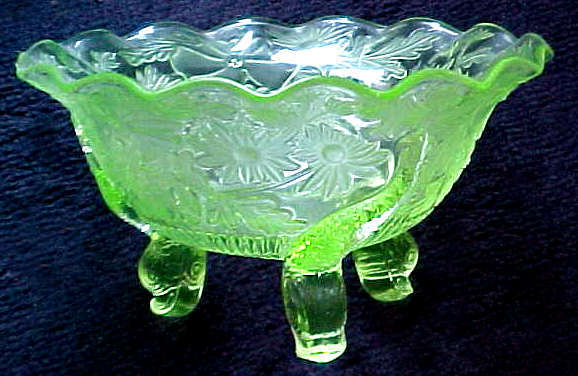Sowerby's Diving Dolphins
A Carnival Glass Case Study (additional research by Angela Thistlewood).
|
Sowerby’s Diving Dolphins bowl - number 1544 - was first made in 1882, and it was shown in their "Pattern Book of Fancy Goods, lX, 1882" (extract, right).
They have a most unusual and decorative appeal, for the bowls stand on three feet, each being styled to form the shape of a dolphin’s head. The dolphin bodies curve sinuously up and onto the main part of the bowl. Around the sides of the bowl are stylised flowers and leaves, the combination of elements forming a most attractive, overall design. When the bowls were originally made, Sowerby’s produced them in malachite, Patent Ivory Queen’s Ware, Giallo, Blanc de Lait (opalescent) Aesthetic Green and ruby (all are rare and may be marked with the peacock head). In the 1920s, when Sowerby began to make iridised glass, Diving Dolphins was one of the moulds that they revived, but one change was made. The interior of the original bowls originally had no pattern but Sowerby decided to update the old plunger by adding their version of Imperial’s Scroll Embossed pattern. This is an undoubted copy that Sowerby subsequently also utilised on several other small Carnival items around the same time. |
The Carnival bowls are known in marigold, but they are also found in rarer colours: amethyst, amber and aqua/teal as shown above from left to right.
There are seven recorded different shapings of the carnival bowls. Most are ruffled (with either 8 or 16 crimps) and some have a smooth outward flare. Much more unusual is the squared shape and rarer still, the rosebowl shape, above left, where the top is curved over towards the middle. Three sided (tricorn) bowls are also known but possibly the rarest of all is the six sided (hexagonal) shape. It’s likely that the rare and unusual shapes, such as the hexagon or the cupped in rose bowl, were hand-shaped by a skilled glassmaker “over the chair”.
There are seven recorded different shapings of the carnival bowls. Most are ruffled (with either 8 or 16 crimps) and some have a smooth outward flare. Much more unusual is the squared shape and rarer still, the rosebowl shape, above left, where the top is curved over towards the middle. Three sided (tricorn) bowls are also known but possibly the rarest of all is the six sided (hexagonal) shape. It’s likely that the rare and unusual shapes, such as the hexagon or the cupped in rose bowl, were hand-shaped by a skilled glassmaker “over the chair”.
The inspirations behind the Diving Dolphins.
Our investigations took us to Brighton, the splendid English south coast seaside town famed for its Georgian architecture, and for its amazing Royal Pavilion which was re-fashioned in 1812 for the prince Regent in the style of an Indian Mogul’s Palace. Brighton rose to fame during the early 1800s when the Prince Regent settled his court there. Suddenly, Brighton became the place to see and to be seen in. In fact between 1820 and 1900, anyone who was anyone visited or lived in Brighton. Royals, politicians, gentry, artists, writers, scientists, industrialists and financiers both from England and abroad had to be seen in Brighton.
In 1846 in the days of the young Queen Victoria, a splendid fountain (shown left) was built in her honour in the centre of Brighton - the Victoria Fountain, an astonishing life sized version of the Diving Dolphins bowl that stands some 32 feet high. It comprises three dolphins, head down, their wonderfully detailed bodies twisting around to form the supports of the bowl above, in essence the identical concept seen in the Diving Dolphins bowl.
Amon Henry Wilds designed and built the splendid Victoria Fountain in 1846 to mark the 27th. birthday of Queen Victoria. The fountain was cast at the Eagle Foundry in Gloucester Road, Brighton, and bears Wilds’ name cast into its base. The ceremony for the inauguration of the Fountain on Victoria’s birthday was undoubtedly very grand and illustrious, for a special piece of music, the Fountain Quadrille, was written to commemorate the occasion.
The dolphin is an ancient symbol of the sea and has long been associated with maritime power, being used by both ancient Greeks and Romans. The motif also has strong associations with Brighton, and it was incorporated into the Coat of Arms of Brighton itself. The builder and architect duo, Amon Wilde and Charles Busby, used the dolphin motif as well as other marine and fossil motifs on many buildings in fashionable Brighton during the early 1800s, buildings that would have been seen and admired by society in general.
A new science that was in its infancy at the same time was that of fossil collecting (indeed the man who first discovered the evidence of dinosaurs did so in the Brighton area in 1822). Ammonite shells and nautilus shapes also began to appear as decorative motifs alongside dolphins on glass and ceramics.
In the USA, the Pittsburgh glass firm of Bakewell Pears & Co. produced a dolphin comport in the 1860s; Percival Vickers & Co. in Manchester, made a frosted glass dolphin vase; in 1882 Heppell & Co. launched their “Dolphin series” and of course, in the same year Sowerby introduced their number 1544, the Diving Dolphins bowl. There were many more examples that confirm that the dolphin motif was in vogue, and in fact Royal Worcester also used the motif in ceramics for at least two of their bowls (comports).
The dolphin is an ancient symbol of the sea and has long been associated with maritime power, being used by both ancient Greeks and Romans. The motif also has strong associations with Brighton, and it was incorporated into the Coat of Arms of Brighton itself. The builder and architect duo, Amon Wilde and Charles Busby, used the dolphin motif as well as other marine and fossil motifs on many buildings in fashionable Brighton during the early 1800s, buildings that would have been seen and admired by society in general.
A new science that was in its infancy at the same time was that of fossil collecting (indeed the man who first discovered the evidence of dinosaurs did so in the Brighton area in 1822). Ammonite shells and nautilus shapes also began to appear as decorative motifs alongside dolphins on glass and ceramics.
In the USA, the Pittsburgh glass firm of Bakewell Pears & Co. produced a dolphin comport in the 1860s; Percival Vickers & Co. in Manchester, made a frosted glass dolphin vase; in 1882 Heppell & Co. launched their “Dolphin series” and of course, in the same year Sowerby introduced their number 1544, the Diving Dolphins bowl. There were many more examples that confirm that the dolphin motif was in vogue, and in fact Royal Worcester also used the motif in ceramics for at least two of their bowls (comports).
Above, from left to right: a ceramic Royal Worcester dolphin bowl (note its dolphin feet and shell motifs), a New Northwood Art Glass Dolphin comport (made in 1999 using the original Northwood mould from the early 1900s), a Sowerby Diving Dolphins bowl in vaseline, 1930s.
Read our feature on the New Northwood Art Glass revival.
Read our feature on the New Northwood Art Glass revival.
